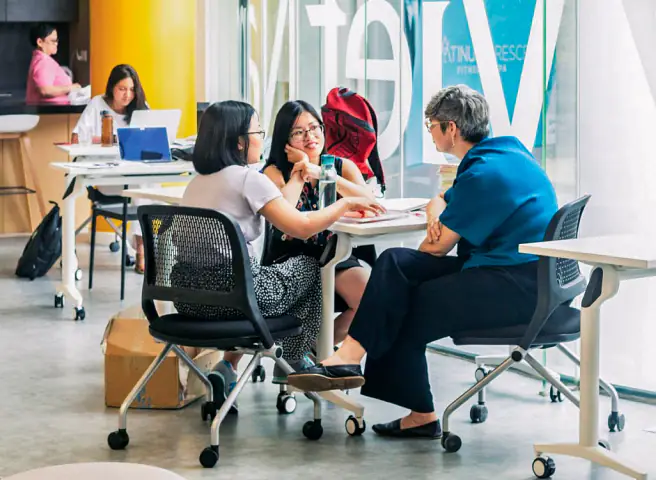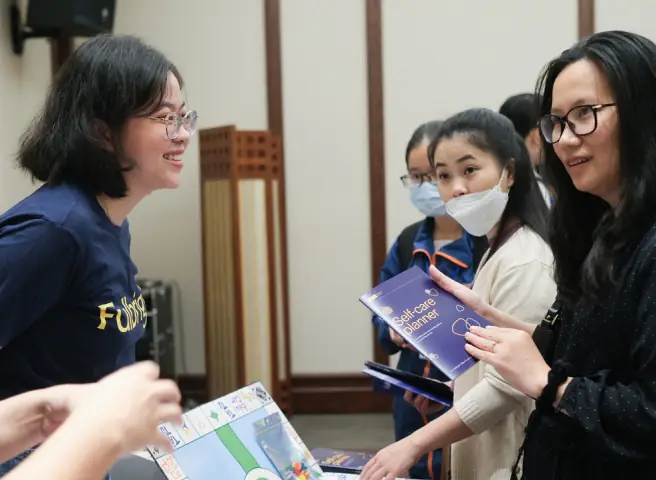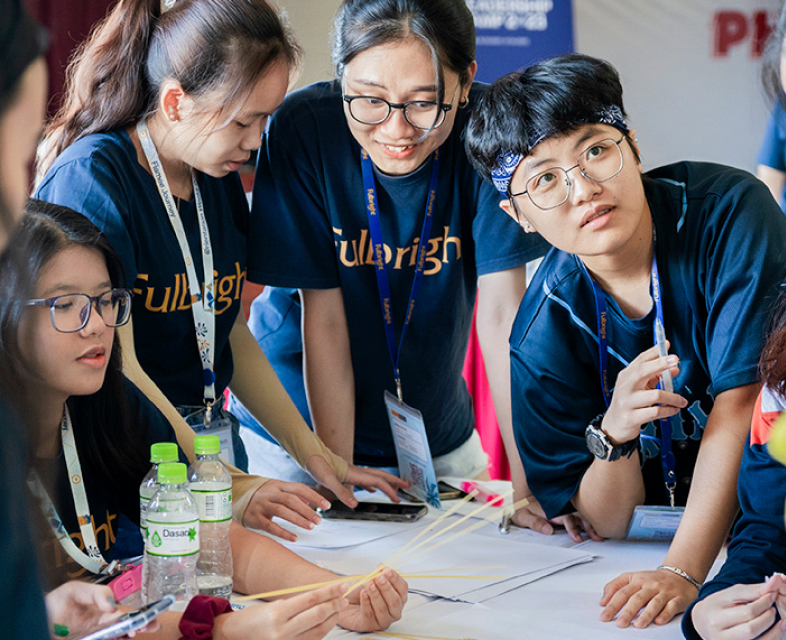
All the things that are happening in the world of technology are directly impacting education and learning systems.Technology has a profound impact on today’s youth. Educational Technology (edtech) is modernizing the entire student experience but could pose many challenges if not implemented with carefully crafted plans. As a pioneering institution to reimagine higher education for Vietnam, Fulbright University co-hosted the inaugural EdTech luncheon with EdTech Asia and InnoLab Asia to bring leaders of all fields in and discuss the future of edtech. In the opening panel on “Acceleration of Digitization in Higher Education in Vietnam,” discussing how universities should change to adapt in a world transformed ever since the pandemic. Here, with the wisdom of esteemed panelists and the participation of curious attendees, many intriguing questions and ideas were sparked.
By the numbers
As social distancing prolongs worldwide, the disruptions of education for students across the globe continue. In fact, the numbers are astonishing: according to UNICEF, over 1.5 billion children’s education was affected by the Covid-19 pandemic and will continue to be throughout 2021. Luckily, education was able to continue despite the disruptions thanks to the vital support of technology. As more and more educators lean into technology, we are presented with the opportunity to reinvent education.

Amidst the chaotic waves of Covid-19 in the last year, the education technology sector received a major boost as many institutions shifted to remote learning. Dr. Nguyen Chi Hieu, CEO of IEG (Innovative Education Group), quoted a new report from Temasek Holdings, Google, and Bain & Company that “40 million people came online for the first time in 2020, pushed the total number of internet users in the South East Asian countries to 70% of the population.” There was also a spike in the amount of new registered users on massive open online course (MOOC) websites, particularly Coursera alone received 20 million new users and had over 35 million new course enrollments in just half a year since mid-March. These numbers may seem overwhelming and the virtual learning space may come as a new thing to many of these new users, but it was not born yesterday. Edtech has been around for quite a while already, the pandemic just brought it to light.
Although edtech has been made more common during Covid-19, it is still underestimated. Mr. Charles Lee, Founder of Coder School, remarked that “When you think about the impact of technology, on education, and across all industries, I think historically, people always underestimated the impact technology would have.” There is tremendous potential for the entire edtech space to be explored and yet utilized. What we have seen in the past year with remote learning, Zoom classrooms, and online courses are only a scratch on the surface of what edtech is.
The edtech space also includes learning assistant tools like AI analytics, AI-assisted grading; all sorts of content, ranging from online content, multimedia content, to interactive content; many learning mediums, which come with classroom aids and learning management systems like Blackboard and Canvas, to name a few. Forbes projected the digital market for learning and teaching to reach $325 billion in 2025, and this prediction was made before the coronavirus happened. It is the quickest growing market in the education industry (900% growth since 2000 according to a research by KPMG), and with the pandemic bringing more attention to it, the market is thriving at an unprecedented rate.
Efforts invested and the road forward
Dr. Hieu explained that “so far, we’re only focusing on increasing the accessibility and the flexibility of remote learning and have yet to tackle the quality metrics of higher education going online.” With the uncertainty as to when in-person teaching will resume, it’s important for us as educators to accept that hybrid learning will be here to stay, and we should start to explore the benefits technology can provide in developing the skills of tomorrow. In a world where technology is shaping every corner, education must take an evolutionary leap for students to thrive in our digital society. And that requires institutions leaders to sit down and figure out some way to move forward.

One of Fulbright’s many initiatives to bring world-class education to Vietnamese students is collaborating with international institutions. In 2020, Fulbright has signed 2 MoUs with Princeton University and Dartmouth College to offer digitally-enabled co-learning environments, namely Princeton’s Global History Lab and connected courses with Dartmouth, so that Fulbright students can participate in the most forward-thinking pedagogical initiatives globally. President Dam Bich Thuy has noted that “COVID-19 has clearly shown, for better and worse, that our world is connected like never before. We are in this together, and we must solve this together. In a time of uncertainties, I am proud to see Fulbright University Vietnam embrace this vision for international collaboration, further enriching the academic dialogue between our countries, as well as educational opportunities for our students.”
These collaborations also expand some blended learning models, in which students learn at least in part through online learning, with an element of self-control over time, place, and path. The more prominent blended learning models become, the more they move education away from the ‘one size fits all approach’, offering students the opportunity to go at their own pace, thus reducing stress and improving retention for both fast and slow learners.
Initiated by Fulbright and IEG Foundation, Pioneering Educators Network (PEN) workshops have been introduced as an effort to promote innovative teaching methods, updated educational trends, cutting-edge pedagogical practices, and the liberal education model in Vietnam as well as in the region. Among these seminars was one about digital learning and teaching by Dr. Ian Kalman, a professor at Fulbright, to share some theoretical perspectives as well as some practical strategies to approach e-learning for educators from across Vietnam. His lecture and presentation opened up many dialogues about how to effectively engage students in virtual classrooms because just as digital technology offers new possibilities for teaching and learning, it also poses many constraints that need to be addressed. “There is also a material and infrastructural need when it comes to digital accessibility, which is not equal among the students. Digital teaching can reduce, but also reinforce inequality,” Dr. Kalman assessed.
Additionally, as we push edtech further and everything becomes artificial intelligence and machine learning, there stances a threat for education to focus more on the ‘superficial’ than on deeper conceptual understandings. Without careful implementation, edtech’s role in ‘making assessment more effective and efficient’ may lead to a disregard for creativity and critical thought. On that note, Mr. Thanh Bui, Founder of Embassy Education, posed a thought-provoking question: “What is the picture of universities in the future? Right now, we have an opportunity to reconsider not just edtech, but also reimagine the higher education systems and how it would progress in our very different world post-pandemic.”
Edtech that connects
If new models for both teaching and connecting emerge in the wake of the pandemic, they will be put to an even greater test in the years ahead: preparing students for a labor market rife with inequalities that have only worsened during the recession. With the rate of everything becomes digitalized very quickly, in 20 years, everything will be automated and as cliché as it may sound, the most critical skills for this young generation to focus on developing is actually human to human interaction.

“The question then remains is how do we bring the humanistic side to edtech. We need to consider the whole picture of education and see where the new technology fits in to enhance these learning experiences. Just because you have the potential to do something or the ability to do something does not mean that you should do it,” Thanh Bui postulated. That is a question for all of us to ponder upon, and that question may not have an answer, but rather require the step-up of industries’ leaders to be the heroes, to inspire other people, to ignite passion and more forward-thinking innovations.
Technology is understandably a poor substitute for maintaining the strong connections we miss seeing each day. But using technology to foster new connections beyond students’ reach actually plays to tech’s competitive advantage: overcoming time, geography, and cost barriers to growing their networks. As a matter of fact, Fulbright held a number of virtual events in 2020, such as David Rubenstein’s How to Lead virtual talk and the YSEALI online panel on the Future of ASEAN, which proved that “we can effectively use technology to try bridging the heroes and create a support network to inspire people,” Charles Lee concluded.

‘Edtech that connects’ holds the immense potential to connect students to people – experts, mentors, near-peers – who can help them reach their goals. Over time, it could help education systems address the social side of opportunity gaps by disrupting the inherent limitations of students’ networks. Edtech is also proving powerful drivers of outcomes that educators are starting to pay more attention to connecting learning to real-world projects and people, expanding students’ professional horizons and connections, and building students’ abilities to connect across lines of difference.
As the majority of students around the world begin yet another term at home, we are faced with the opportunities to create a new (and somewhat improved) normal for students and teachers. The challenges, such as technological infrastructure and access to hardware, are surmountable with time and effort. With the right approach, technology, and resources, we can prepare students for the jobs of tomorrow, on platforms that are becoming more accessible and using methods proven to be more powerful. As students continue to grow hungrier and more inquisitive for knowledge and technology, reimagining higher education is something to be excited about, and it all starts now.
Bảo Trâm







